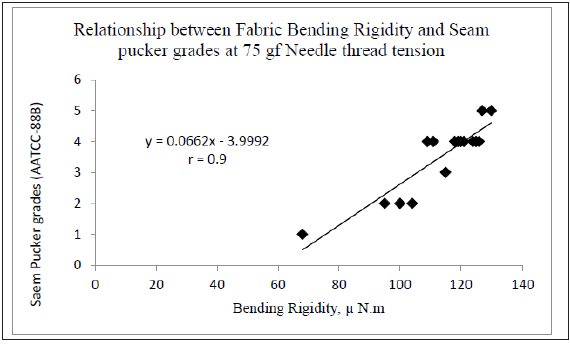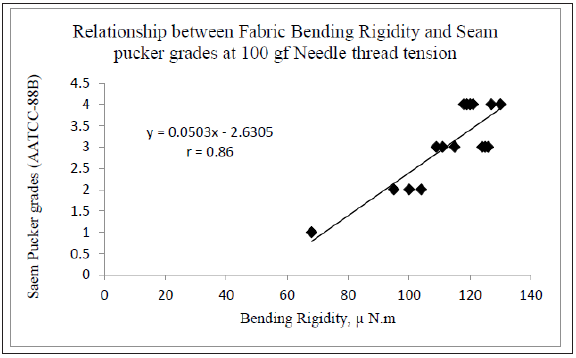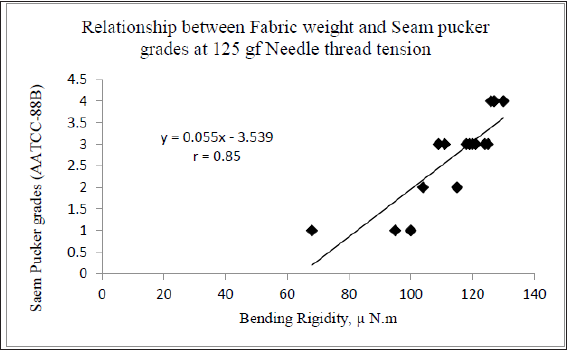- Submissions

Full Text
Trends in Textile Engineering & Fashion Technology
Experimental Analysis of Static Thread Tension on Seam Appearance
Muhammad Amir*
Department of Textile Engineering, NED University of Engineering and Technology, Pakistan
*Corresponding author:Muhammad Amir, Department of Textile Engineering, NED University of Engineering and Technology, Karachi, Pakistan
Submission: July 07, 2020; Published: August 13, 2020

ISSN 2578-0271 Volume 6 Issue 2
Abstract
Investigate the impact on seam appearance due to fabric weight, bending rigidity and static thread tensions at single needle lock stitch sewing machine. The intersection among the stated parameters is crucial at stitched fabric to predict seam appearance. Sixteen different weights of fabrics are investigated at fixed foot pressure, needle diameter, bobbin thread tension to explore the effect of intersection. Present work is suggested that intersection of bending rigidity of fabric and thread has strong linear relationship to magnitude of static needle thread tension at lock stitched sewing machine to predict the aesthetic seam appearance of stitched fabrics
Keywords:Seam pucker, Thread tension, Lock stitch, Bending Rigidity
Introduction
In the clothing industries, fabric, sewing thread and sewing machine plays an important
for the seam appearance of stitched fabrics [1-7]. Influence mechanical and physical properties
of sewing thread are important to predict and evaluate seam pucker. Seam pucker is a crucial
tool to examine the aesthetic seam appearance of stitched fabric. In the stitching of lightweight
woven fabrics, bending rigidity is a tool to predict the seam appearance of a stitched fabric. It
was established that fabric bending rigidity has high magnitude in comparison with sewing
thread to produce balanced seam without pucker.
In contrast bending rigidity of sewing thread should be integrated with static sewing
thread tension at sewing machine to elude seam pucker. The present work is focused on the
experimental exploration of fabric bending rigidity with increasing trend of static needle
thread tension at single needle sewing machine on visual assessment of pucker at 80 stitched
fabrics samples.
Materials and Methods
The visual assessment of pucker
Figure 1:AATCC88B the set-up of the five standards and samples.

A visual assessment procedure has been developed by the American Association of Textile Chemists and Colorists (AATCC-88B). In this procedure, three observers compare three specimens of a particular seam with a series of five photographs of increasingly severely puckered seams, numbered 5 to 1. Grade 5 is given to a sample with no puckering while a seam with very severe puckering is graded 1. Figure 1 shows an example of the set-up of the five standards and samples of one of our experimental seams. This procedure was used to assess visually the seams produced using same threads to stitch all sixteen fabrics at 25gf, 50gf, 75gf 100gf and 125gf, i.e. there were 80 seams in all.
Properties of the experimental materials
Threads: The core spun sewing thread is used which have mean diameter 0.0436cm bending rigidity 4.1x10-3gfcm2 per thread. Thread diameter was assessed microscopically at 20 points along the thread. Also, the thread bending rigidities were evaluated using the KES-FB2 tester.
Fabrics: The Sixteen different weight fabrics (g/m2) are used to investigate the effect of bending rigidity of fabric with increasing trend of needle thread tension while other factors kept fixed. The fabric bending rigidities (BR) were measured using the FAST-2 while the fabrics are of thin shirting hardly compressible material. Table 1 gives the mean of five tests in each case.
Table 1:Fabric Evaluation.

Single needle sewing machine setting: Machine model: Fully digital, DDL9000c, Machine was pre-set at the fixed settings as under:
A. Sample Size = 250X50mm
B. Speed = 3000 stitchs/min
C. Stitch density= 5 stitches per cm
D. Foot Presser pressure = 5.1kgs
E. Bobbin thread tension was adjusted according to machine
standard.
Fabric was made to be wrinkle free prior to stitching. Centre
was marked to make sure the stitch is made at center. Total 80
samples will be investigated where sixteen fabric samples were
stitches from each weight of the fabric at 25gf 50gf, 75gf, 100gf,
125gf needle thread tension.
Results
The results in Table 2a & 2b are plotted in Figures 2-6. All set of data exhibit a strong linear relation (the correlation coefficient r = in all cases), which suggests that the bending rigidity of the fabric is considered with static needle thread tension as useful measure of the tendency of a seam to pucker or elude to pucker. It is revealed that relative magnitude of fabric and thread bending rigidity should be considered with static tension of needle thread at sewing machine to elude seam pucker for different weight of fabrics.
Table 2a:Pucker assessment at different needle thread tension.

Table 2b:Pucker assessment at different needle thread tension.

Figure 2: Seam appearance at 25gf Needle thread tension.

Figure 3:Seam appearance at 50gf Needle thread tension.

Figure 4:Seam appearance at 75gf Needle thread tension.

Figure 5:Seam appearance at 100gf Needle thread tension.

Figure 6: Seam appearance at 150gf Needle thread tension.

Conclusion
The experimental result revealed that static sewing thread tension is played an important to improve the garment seam appearance. The intersection of relative magnitude of bending rigidity of fabric and thread with static needle thread tension at sewing machine reflects strong correlation to predict the seam appearance. The presented experimental finding provides the industrial guideline to select the static needle thread tension along with fabric weight, bending rigidity to improve seam appearance.
References
- Amir, M, Gerry, George (2019) A model of seam pucker and its applications Part I: theoretical. The Journal of The Textile Institute 1-4.
- Amir M (2017) An investigation into the measurement, prediction and elimination of seam pucker, Heriot-Watt University, Scotland, UK.
- Galuszynski S (1986) Seam Pucker, USA.
- Mori M, Niwa M (1994) Investigation of the performance of sewing thread. International Journal of Clothing Science and Technology 6(2/3): 20-27.
- Muhammad A (2019) A Model of Seam Pucker and Its Applications. Part II: Experimental. The Journal of The Textile Institute 111: 1-4.
- Stylios G, Lloyd D (1989) The mechanism of seam pucker in structurally Jammed Woven fabrics. International Journal of Clothing Science and Technology 1(1): 5-11.
- Stylios G, Lloyd D (1990) Prediction of seam pucker in garments by measuring fabric mechanical properties and geometric relationships. International Journal of Clothing Science and Technology 2(1): 6-15.
© 2020 Muhammad Amir. This is an open access article distributed under the terms of the Creative Commons Attribution License , which permits unrestricted use, distribution, and build upon your work non-commercially.
 a Creative Commons Attribution 4.0 International License. Based on a work at www.crimsonpublishers.com.
Best viewed in
a Creative Commons Attribution 4.0 International License. Based on a work at www.crimsonpublishers.com.
Best viewed in 







.jpg)






























 Editorial Board Registrations
Editorial Board Registrations Submit your Article
Submit your Article Refer a Friend
Refer a Friend Advertise With Us
Advertise With Us
.jpg)






.jpg)














.bmp)
.jpg)
.png)
.jpg)










.jpg)






.png)

.png)



.png)






